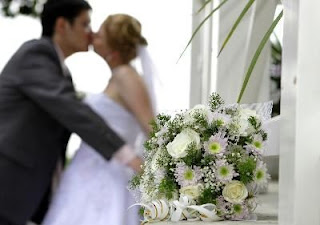Wedding by Capture
The earliest weddings weren't about love and wanting to spend the rest of your life with that special someone. Instead they were about politics and survival. In early days, the bigger a tribe, the better protected they all were against predators, other tribes and villages and the elements. In other words, there was safety in numbers.In these early times, women would be kidnapped by the groom and some of his trusted friends or relatives. This group of men is now represented by the Best Man and grooms men that make up a modern day wedding party. Once the bride was kidnapped, she was considered the groom's property and a member of his tribe. The couple would then stay away for as long as possible to avoid retaliation. This period of time has evolved to become what is now known as the honeymoon.
Political Weddings
If a bride wasn't being captured by her groom, she was being used as a tool to bring two tribes or high ranking families together. Brides were also bartered for money, livestock, land or other goods. Marriages were also used to elevate social status for one or both couples. In fact, a married couple might never have met prior to their wedding day!Medieval Times
During Medieval times, laws regarding marriage changed and women were no longer allowed to be bartered, sold or exchanged for goods of any kind. If a couple wanted to get married, a priestly blessing was required first. It was also illegal for secret wedding ceremonies to be held. A wedding was still arranged in many cases, and contracts were even drawn up listing the terms and rights of all parties involved. Weddings among royalty and aristocracy were often arranged when the bride and groom were only ten or twelve years old. These weddings were more about property and inheritance than love.That isn't to say marriages for love didn't occur. This was mostly the case with the lower classes, for whom possessions and social standing wasn't so important.
Elizabethan Weddings
During Elizabethan times, weddings began to more represent weddings we attend today. At an Elizabethan wedding ceremony one could expect to see bridesmaids, wedding rings, and the exchange of wedding vows. Women were even beginning to carry herbs or flowers. While these were happy, fairy tale occasions, marriages were still mostly arranged. Even though the Happy Couple often didn't meet until their wedding day, the well-to-do groom was often presented with a picture of his betrothed beforehand so he would know what she looked like.Prior to the wedding, the groom was presented with a dowry. In many cases, this was the reason behind the wedding. A dowry wasn't necessarily money; it was also land or goods. While technically paying a "bride price" was illegal, a dowry was more or less considered a wedding gift. The families were able to get around the bride price law on this technicality.
Colonial Weddings
Once again, for people of wealth, marriages were more business arrangement than loving relationship. Courtships and marriages were arranged, usually by the father of the young men, who would write a letter to the young lady's father requesting permission to court. These letters would usually list the attributes of the young man in question and why the union would be a profitable one for all concern. If the father of the young lady agreed, courtship and, after a negotiation of dowry, marriage would eventually take place.Southern weddings tended to be more festive than those in the North where solemn civil ceremonies were common place. Southern weddings were always followed by a large reception with food, drink, and games, whereas Northern weddings didn't have much of a party afterwards.Victorian Weddings
As soon as a woman finished school (around the age of seventeen or eighteen), she would "come out" or make her debut. This was a very important and exciting time as she had been groomed for marriage all of her life. New clothes and accessories would be purchased so she would look her best and impress any potential suitors. Men, of course, viewed courtship as more business than pleasure. Land, money, and the family business were all carefully researched since what belonged to the woman would be turned over to the man upon marrying. The upper classes would usually meet at social engagements such as parties. The lower classes would meet through church and church sponsored functions.If a couple enjoyed each other's company and shared a similar lifestyle and social standing they might become engaged. Love was generally not an issue as marriage was still considered a business transaction. Since women were allowed a certain amount of independence in choosing their suitors, they did at least have some say in the matter and in many cases didn't marry unless they were a little fond of each other.
via: http://weddings.lovetoknow.com/wiki/History_of_Weddings






没有评论:
发表评论